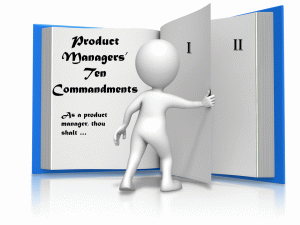There are many types of product managers in diverse industries. Yet, there are commonalities that bind them together. A few guidelines keep popping up in many articles. Here are those rules every product manager should follow, the Ten Commandments.
The Product Managers’ Ten Commandments
As a product manager, thou shalt…

I. Master customer insights
The cornerstone of your product strategy is the ability to attract and keep high-equity customers. Even though product is in your job title, your most important role is to create benefits for (the “right”) users. Who are the most important consumers and why? How are the most important customers different from those who are more short-term or opportunistic?
II. Focus on outcomes
Start with the end in mind. That’s a common recommendation, but one often lost in the business of day-to-day life. The reasons for a product’s existence are to produce customer benefits and to provide present or future financial returns. The product has to accomplish strategic goals to justify its survival.
III. Recognize you are part of a team
As you focus on outcomes, you can’t do everything alone. Other functions in the organization contribute to the planning and execution of product performance. Acknowledge that. Appreciate that. Accept the opportunities and boundaries inherent in teamwork. Always check your ego at the door.
IV. Heed the big picture
Products live within ecosystems. There are ancillary products, competitors, complementors, and niche-specific offerings. Your product’s success may rely on other products. Or it may be a critical component for another device. That’s the reality of reciprocity. Stay abreast of trends, competitor strengths and weaknesses, regulatory and social changes, and the need to balance past, present, and future.
V. Establish portfolio thinking
As part of big-picture reflections, product managers should establish a portfolio mindset. There are, in fact, three common sub-portfolios: R&D (visionary) concepts, work-in-process new products, and existing products. The first category contains ideas that could enter a future new-product pipeline. They are the “fuzzy front end” inspirations. The second category houses products somewhere in the development process. They demand team attention and occasional re-balancing. The final category contains assets that generate current cash flow for the organization. As stewards of this final sub-portfolio, product managers determine the best approaches to profitable life-cycle management.
VI. Monitor priorities
Portfolio planning demands you monitor what is and is not important. You need to prioritize backlogs (a fancy word for ‘tasks’), features, and products. Prioritize tasks that are urgent, have high financial repercussions, and/or could impact brand equity. Process improvements and next steps in a project plan are next-level priorities. In terms of features and products, give higher attention to those that fit the product strategy and targeted customers.
VII. Generate Plan B
Stick to your plan unless something in the product ecosystem causes a significant change in priorities. Then transition to a revised plan. The sooner you can cut your losses when transitions occur, the quicker you can recover momentum. Avoid “magical thinking,” and be willing to play “devil’s advocate.” Whatever triggered the need to generate a new plan, don’t move so fast you add failure to failure.
VIII. Defend with data
Go beyond whims and assumptions when planning or re-prioritizing. Use data, both quantitative and qualitative. Decide what is relevant and what is superficial. Be firm.
IX. Persuade with storytelling

Stitch together the qualitative and quantitative details to create a picture that clarifies your thinking. Make it visual, with relevant charts, demonstrations, animations, models, and illustrations. You can even craft words alone into customer and industry stories that convey and strengthen powerful points. But be concise. Simplify, simplify, simplify.
X. Avoid cognitive overload
Product managers face information overload. They can become the central repository (think dumping ground) for everything product-related. Use planning and implementation techniques that organize your workflow and thought processes. Flowcharts, action maps, checklists, templates, and schedules are common tools of time organization.
Flowcharts are diagrams of operations, activities, and decisions, with symbols to show the various phases of a process.
Action maps are visual or textual models of future direction.
Checklists, while basic listings of tasks, have power because of their simplicity.
Templates are fill-in-the-blank worksheets that help minimize overlooking something important.
Schedules present annotated calendars with owners, activities, and deadlines identified.
